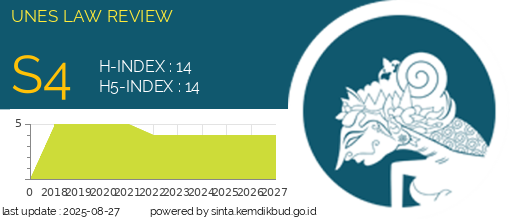Pelaksanaan Indikasi Geografis oleh Masyarakat Perlindungan Indikasi Geografis (Mpig) Pasca Sertifikasi di Kepulauan Meranti dan Solok
DOI:
https://doi.org/10.31933/unesrev.v6i1.877Keywords:
Geographical Indication, GIPS, Economic Progress, Meranti, SolokAbstract
Geographical indications on a product can increase the economy if used and protected properly. However, not all registered Geographical Indication products experience significant price increases after certification, such as Sago Meranti. Therefore the role of the Geographical Indication Protection Society (GIPS) in post-certification governance is very important and influences the welfare of its members. This research is a normative-empirical research through a comparative approach using primary and secondary data. Based on the research, the results obtained were: 2. It is known that the implementation of Geographical Indications by the Sago Meranti Community Association (AMSM) has not been running optimally, marked by the not using the Geographical Indication logo on its product packaging which has not caused an increase in the price of Sago products, on the other hand, Geographical Indication Protection Society of Liberika Coffee Rangsang Meranti and Bareh Solok have experienced an increase in yield. production and price increases so as to have an impact on increasing the income of its members. 3. Alternative models used for Sago Meranti Community Association are a. Formation of legal policies by the Regional Government b. Management of quality and characteristics through the development of internal control guidelines, and 3. Marketing methods through the use of the Geographical Indication logo on product packaging and cooperation with the private sector and the Government.
Downloads
References
Ahmad M. Ramli dan Miranda Risang Ayu, 2019, Indikasi Geografis dan Kekayaan Tradisi dalam Teori dan Praktik, PT Refika Aditama, Jakarta.
Bentham dan Mill editor oleh John Troyer, 2003, The Classical Utilitarians, Hacket Publishing Company, Inc.
Calboli Irene and Wee Loon. 2017. Geographical Indications at th Crossroads of Trade, Development, and Culture, Cambridge University Press, Cambridge.
Carayannis Elias G. dan David F.J Campbell, 2010, Triple helix, Quadruple helix and Quintuple helix and how do Knowledge, Innovation and the Environment relate To Each other? a Proposed Framework for a Trans-disciplinary analysis of Sustainable development and Social Ecology, International Journal of SocIal ecology and SuStaInable development, Vol.1, No.1, hlm.51.
Maria Alfons, 2016, Kepastian Hukum Perolehan Hak atas Kekayaan Intelektual, Jurnal Hukum Jatiswara. Vol.31, No 2. hlm 304.
Miranda Risang Ayu. 2006. Memperbincangkan Hak Kekayaan Intelektual Indikasi Geografis. PT. Alumni, Bandung.
Muhaimin, 2020, Metode Penelitian Hukum. Mataram University Press. Mataram
Peter Damary dan Riyaldi. 2018. Modul Pelatihan Indikasi Geografis, Indonesian-Swiss Intellectual Property Project (ISIP). Jakarta.
Rianti Fauza Mayana, 2004, Perlindungan Desain Industri Diindonesia, PT Gramedia Widiasarana, Jakarta.
Undang-Undang Republik Indonesia Nomor 20 Tahun 2016 tentang Merek dan Indikasi Geografis
Downloads
Published
How to Cite
Issue
Section
License
Hak cipta :
Penulis yang mempublikasikan manuskripnya di jurnal ini menyetujui ketentuan berikut:
- Hak cipta pada setiap artikel adalah milik penulis.
- Penulis mengakui bahwa UNES Law Review berhak menjadi yang pertama menerbitkan dengan lisensi Creative Commons Attribution 4.0 International (Attribution 4.0 International CC BY 4.0) .
- Penulis dapat mengirimkan artikel secara terpisah, mengatur distribusi non-eksklusif manuskrip yang telah diterbitkan dalam jurnal ini ke versi lain (misalnya, dikirim ke repositori institusi penulis, publikasi ke dalam buku, dll.), dengan mengakui bahwa manuskrip telah diterbitkan pertama kali di Jurnal UNES Law Review.



















